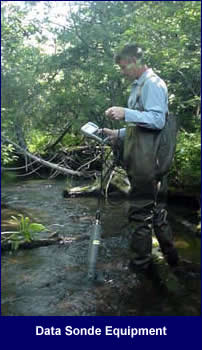Region 1: EPA New England
Data Sondes
General Description
The Sonde equipment described below is utilized in measuring key water quality parameters in the field. This information is commonly used by state environmental agencies as criteria for establishing water quality standards and determining whether various uses of the water body are being supported. Certain species of fish and invertebrates are limited by specific temperature ranges, dissolved oxygen levels in the water, and turbidity and conductivity. Monitoring of these parameters is often an indication of what organisms a biologist would expect to find in the sampling area.
Like other instrument probes, the sonde must be calibrated before it is used to measure the environmental samples. Once the instrument is calibrated correctly, the sonde is able to produce the following information regarding the water quality of stream ecosystems: temperature, pH, conductivity, turbidity, and dissolved oxygen.
Equipment
- Thermometer
- pH Standards of 4, 7, and 10
- Conductivity standards
- Turbidity standards
- De-ionized water
- Data sonde with attached pH, Conductivity, Dissolved Oxygen, and Turbidity probes
- Multi-parameter Display System
- Sonde communications cable
- Data sheets and writing utensils
Significance to Biological Integrity of Stream Ecosystem
 All
these different parameters are important measurements of the biological
integrity of a stream ecosystem and can be very indicative of what
one would expect to find in the system.
All
these different parameters are important measurements of the biological
integrity of a stream ecosystem and can be very indicative of what
one would expect to find in the system.
Temperature: Aquatic organisms from microbes to fish are dependent on certain temperature ranges for their optimal health. Optimal temperatures for fish depend on the species: some survive best in colder water, whereas others prefer warmer water. If temperatures are outside this optimal range for a prolonged period of time, organisms can become stressed, die off, or move out of the system to more amenable habitats.
pH: The pH scale measures how acidic or basic a substance is. If the pH of stream water measures a pH of 7.0, it is considered “neutral,” ands the basic and acidic inputs to the stream are in balance. Most aquatic organisms bode well in pH ranges around six to seven. Lower pH ranges can drive fish and invertebrates from the area and affect the decomposition rates of organic materials (ie. Leaves), which are important food sources for organisms at the bottom of the food chain. Streams maintain their pH levels primarily from the chemical make up of the surface geology in an area, and depending on the types of rocks and minerals, can be highly sensitive or highly tolerant to non-natural chemical influxes to the system. Most of the streams in New England fall into this former category and are minimally capable of “buffering,” or maintaining a favorable pH when acidic inputs such as acid rain occur to their system. This sensitivity to acidic influxes can have critical detrimental impacts to the resident biota.
Conductivity: Conductivity is a measure of the ability of water to pass an electrical current. Each stream tends to have a relatively constant range of conductivity that, once established, can be used as a baseline for comparison with regular conductivity measurements. Significant changes in conductivity could then be an indicator that a discharge or some other source of pollution has entered a stream.
Turbidity: Turbidity is a measure of water clarity, how much the material suspended in water decreases the passage of light through the water. Heavy silt and organic suspensions can clog fish gills, reduce resistance to diseases in fish, lower growth rates, and affect egg and larval development. As particles settle, they can blanket the stream bottom, especially in slower waters, and smother fish eggs and benthic macro-invertebrates. Some sources of turbidity include: soil erosion, waste discharge, urban runoff, and eroding stream banks.
Dissolved Oxygen: Oxygen is measured in its dissolved form as % dissolved oxygen or milligrams per liter. If more oxygen is consumed than is produced, dissolved oxygen levels decline and some sensitive aquatic life may leave the habitat, weaken, or die. Sources of high dissolved oxygen consumption include wastewater from sewage treatment plants, storm water runoff from farmland or urban streets, animal feedlots, and failing septic systems.
